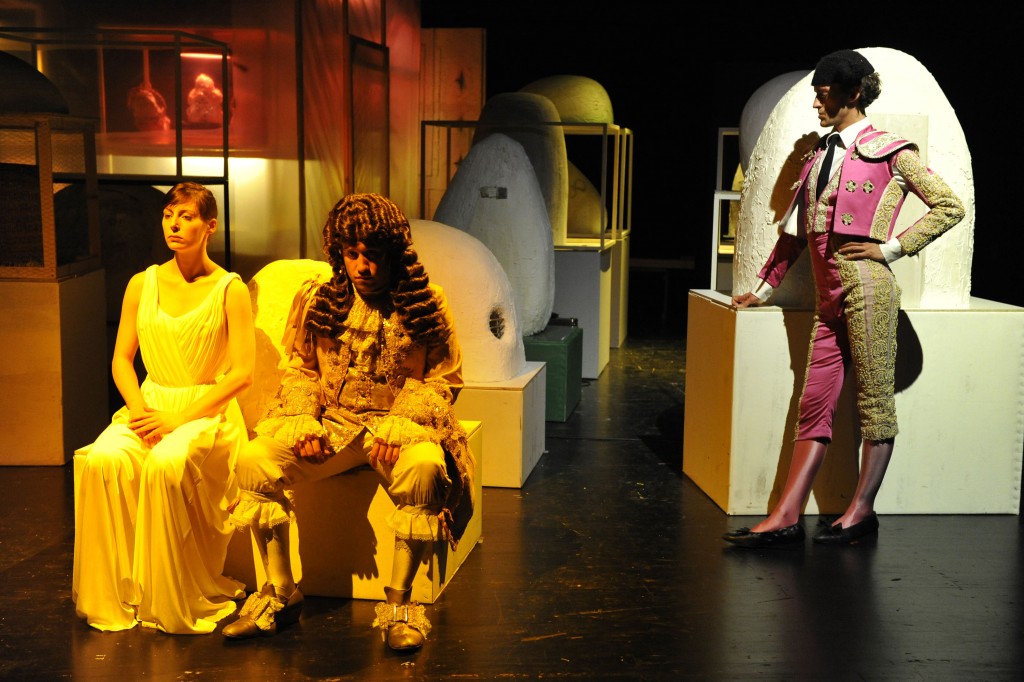“Pastiche” is a musical show based on the personality and musical background of each of its participants. As the piece progresses, they are confronted to each other, thus eventually bringing their languages and the way they interact together, forming an ensemble piece.
The title “Pastiche” contains in itself what the show will become: in the music glossary, it refers to a blended form, whose parts have different origins but form a defined whole, rather than a medley. This practice was usual in the nineteenth Century opera, and is sometimes also called “fragments”.
For instance, the play can start with a performer, who gets on stage et reproduces his favorite musical piece, but only by using his own body, voice and movements: no external artifice is allowed yet. Any kind of music is permitted, from traditional folk to classical music, from rock to electronic compositions. A second performer will then enter stage, starting his own musical piece, gradually being helped by the first actor and generating an attempt at interacting and being together.
As the show progresses and the performers influence one-another, the attempts to play together gets richer and more intertwined. The number of actors-musicians on stage grows and each will have his own way to influence and convince the others; some might be insistent, some seducing, others discreet. More unity will arise from the process, certainly towards a mass-minimalism.
This project seems very formal and abstract, but a second layer of interpretation shall be built upon this abstraction, allowing each member of the audience to connect with the different types of acting, the musical references or the general atmosphere. Costumes will also play an important part towards this aim and will therefore be well taken care of.
The personality of the actors will definitely play a crucial role at the beginning of the creation process, but the directing needs to be formally precise to fine tune this work. In that sense, the writing of “Pastiche” will take place during the rehearsals rather than before. We always proceeded in such manner with Velma et noticed it was a way of working closer to choreography than to theater. The music is closer to choreography as well, insofar that it appeals to emotions generated on an abstract, non-narrative level, while the audience builds its own narrative nevertheless.
PASTICHE
Direction: Christian Garcia-Gaucher
Direction collaboration: Christophe Jaquet
Direction assistant: Olivier Bachmann
Dramaturgy: Erik Altorfer
Costumes: Simone Hoffmann
Coordination: Gabriele Bieri, Miklos Ligeti
Stage design: Andres Lutz & Anders Guggisberg
Scenery construction assistance: Stefanie Liniger, Anna Bucher
With: Henriette Cejpek, Jeanne Devos, Sebastian Edtbauer, Michael Frei, Andri Schenardi, Heiner Take, Diego Valsecchi, Christophe Jaquet, Christian Garcia-Gaucher
MEILER, HAUBEN UND GLOBEN is a production of the Bern Stadttheater
With the friendly support of: Migros Kulturprozent, SSA – Swiss Society of Authors, Zuger Kulturstiftung Landis & Gyr
Mediapartner: Berner Kulturagend
MEILER, HAUBEN UND GLOBEN | Autors’ show
29/05/2010 | 18.00 | Bern | Stadttheater | PREMIERE
30/05/2010 | 18.00 |Bern| Stadttheater
01/06/2010 | 19.30 | Bern | Stadttheater
02/06/2010 | 19.30 | Bern | Stadttheater















